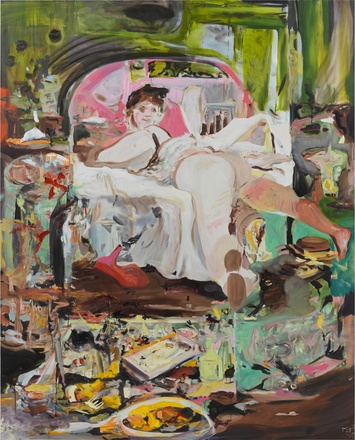Cecily Brown
Nana (2023)
Several constants run through Cecily Brown’s work: oscillation between abstraction and figuration, citations of art historical traditions, erotically charged scenes, and a pop-culturally informed humor. In her large-scale paintings from around the turn of the millennium, figures appear in pursuit of their own sexual desires or as reflections of the viewer’s urges. A female figure stretches the pink curves of her buttocks into the pictorial space of “Service de Luxe” (1999), her torso split off by the edge of the painting. The colors and forms of the depicted flesh merge into the ground, opening the latter up for libidinous projections. In “No You for Me” (2013), which can be seen this year in Brown’s solo show at the Metropolitan Museum of Art in New York, the painter also directs the gaze toward a female backside; here, however, the figure rests on her stomach at the center of the painting, her indicated face turned to the viewer. In “Nana” (2023), her second edition for TEXTE ZUR KUNST, Brown returns to the painting “No You for Me.” She not only refers to her own work but takes the title from Édouard Manet’s controversial 1877 painting that depicts a courtesan with her waiting client. While Brown has claimed a place for herself in art history, she transposes “Nana” into the here and now: more strongly contoured than in “No You for Me,” the figure emerges from the picture plane of the Ditone print, and her surroundings grow more distinct. For whom she turns her head remains unclear.

